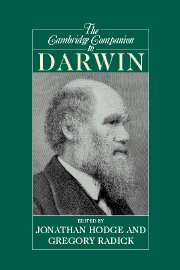Book contents
- Frontmatter
- Introduction
- PART I DARWIN’S THEORISING
- 1 The making of a philosophical naturalist
- 2 The notebook programmes and projects of Darwin’s London years
- 3 Darwin on generation, pangenesis and sexual selection
- 4 Darwin on mind, morals and emotions
- 5 The arguments in the Origin of Species
- PART II HISTORICAL CONTEXTS
- PART III PHILOSOPHICAL THEMES
- PART IV WAYS FORWARD
- Guide to further reading
- List of references
- Index
1 - The making of a philosophical naturalist
from PART I - DARWIN’S THEORISING
Published online by Cambridge University Press: 28 May 2006
- Frontmatter
- Introduction
- PART I DARWIN’S THEORISING
- 1 The making of a philosophical naturalist
- 2 The notebook programmes and projects of Darwin’s London years
- 3 Darwin on generation, pangenesis and sexual selection
- 4 Darwin on mind, morals and emotions
- 5 The arguments in the Origin of Species
- PART II HISTORICAL CONTEXTS
- PART III PHILOSOPHICAL THEMES
- PART IV WAYS FORWARD
- Guide to further reading
- List of references
- Index
Summary
The law of the succession of types, although subject to some remarkable exceptions, must possess the highest interest to every philosophical naturalist.' When Charles Darwin penned these lines in 1837, he was twenty-eight years old, fresh from the Beagle voyage, and a self-described 'philosophical naturalist.
As such, he was engaged neither in natural history nor in natural philosophy. Natural history, in the tradition of the Swedish botanist Linné (Linnaeus), concerned the systematic ordering of animals and plants and the discovery of new species. Natural philosophy, in the tradition of Descartes and Newton, concerned the search for general physical laws. Darwin was aligning himself with investigators whose work fell outside these traditions. Some were interested in a comparative anatomy based on ideal forms - the so-called 'transcendental' anatomists, such as the French zoologist Etienne Geoffroy Saint-Hilaire and his Scottish disciple Robert Knox. Others, such as the geologist Charles Lyell, were interested in building comprehensive theories about the earth and its inhabitants.
Philosophical naturalists spoke of various ‘laws of life’. They debated the existence of laws, for example, said to relate taxonomic groupings in regular circular arrangements, as in the so-called quinarian system, or to govern organic functions such as the development of the embryo. Another law under discussion was the law of the succession of types. In different areas around the world, it seemed, living species had replaced extinct species of the same kind or type. Living armadillos in South America, for instance, had apparently replaced the armadillo-like creatures fossilised in the rocks of that continent.
- Type
- Chapter
- Information
- The Cambridge Companion to Darwin , pp. 17 - 39Publisher: Cambridge University PressPrint publication year: 2003
- 11
- Cited by



